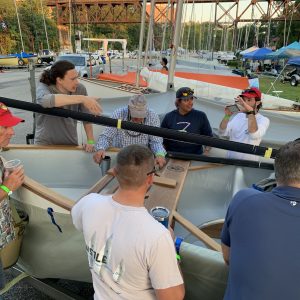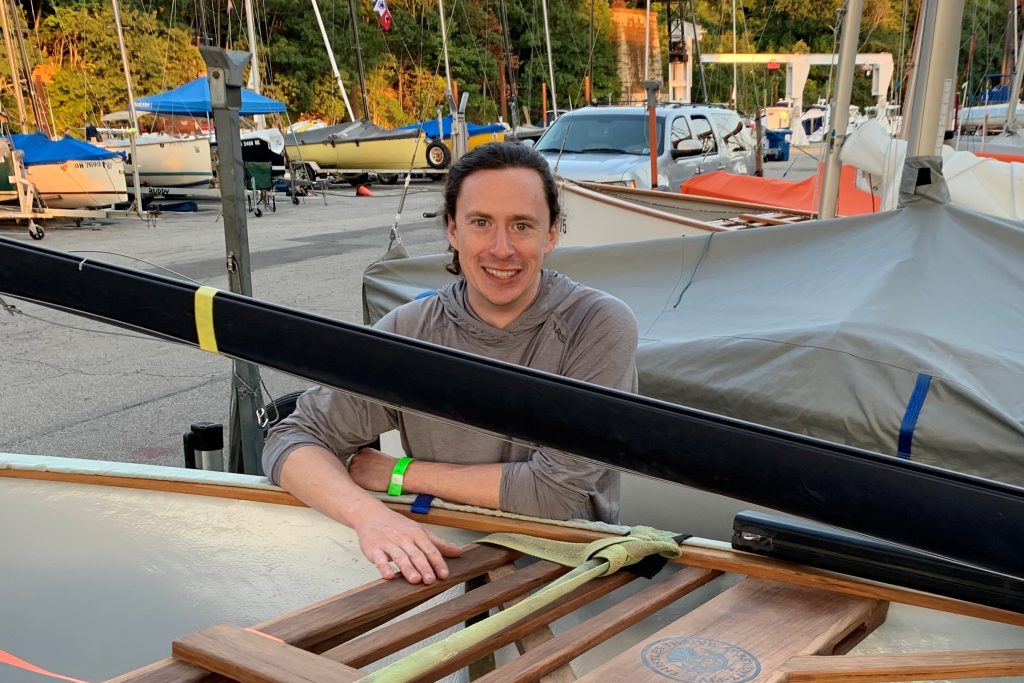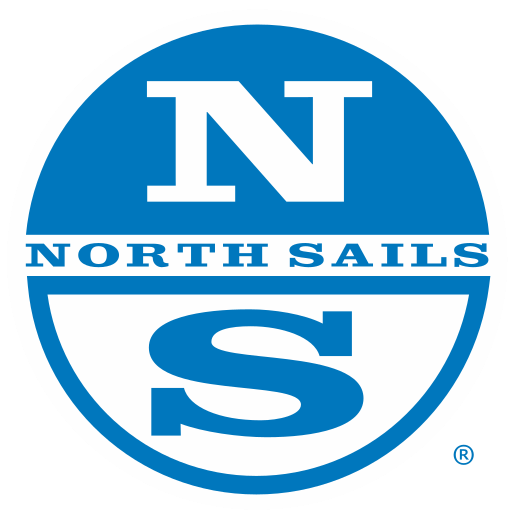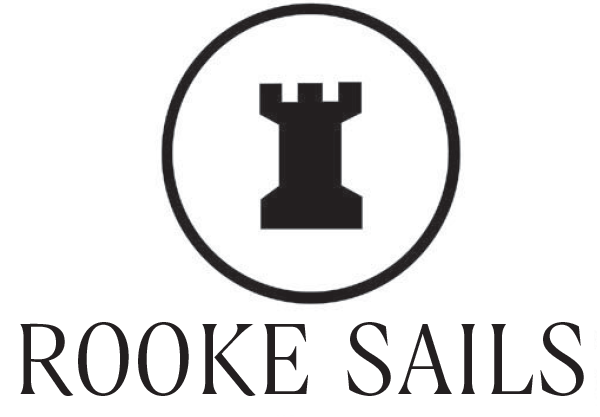Thistle Builds and How He Got Here – An Interview with Alex Venegas
By Nicole Shedden, Thistle 1784
Originally published in the 2021 October/November issue of the Bagpipe
The first Thistle made by Beacon Composites, #4052, debuted at the 2021 Lake Erie Districts. “Alex made some great modifications to the GMW design. The woodwork is excellent, and the quality of the fiberglass joints is outstanding. All in all, I could not be more pleased with the boat,” said Fred Hunger, owner of 4052. Then Beacon’s second Thistle showed up at Nationals. Like any new boat, people crowded around to admire it. Unlike other new boats, everyone claimed it as theirs – “Hey, stop leaning on my new boat!” – until Mike Minett won the raffle for Thistle 4075 on Friday night.
Whether or not you’ve seen a new Beacon Composites Thistle, you’re sure to have heard about the new builder and construction process. Here’s an opportunity for you to meet Alex Venegas (ven-AY-gas), owner of Beacon, and learn exactly how he’s making these new Thistles.
Starting with the hull
Alex starts each new boat with something old – the molds from Great Midwest Yachting Company, giving Alex’s hulls a proven shape. After waxing the molds and adding forms for the centerboard and transom, Alex sprays in the paint. “I can get any color; just ask!” he says. Once the paint is dry, he cuts fiberglass and lays it in the mold – dry.
Is he missing something? Where’s the resin? This is where Beacon Composites’ process differs from the typical glass boat construction. Alex uses an infusion process to add resin to the fiberglass. “I put a bag over the whole boat and add vacuum lines that go into a bucket of resin. When everything’s ready, I turn the valve, and the resin starts flowing because of the pressure difference.”
In 27 minutes, the fiberglass is wet with an even distribution of resin. Alex keeps the mold under vacuum overnight and then removes the vacuum bag the next day. Then hull stays in the mold for about a week as everything hardens.
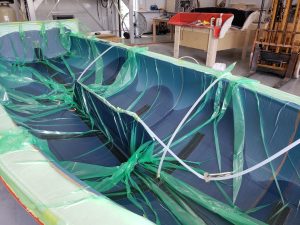
How do we know the infusion process works?
Alex is used to this question. “The main concern is that it’s too good of a process,” he says with a smile. Understandably, the Thistle Class Association doesn’t want a new boat that’s so stiff it has a distinct advantage over older boats. After all, our class thrives because older Thistles hold their value. Chris Pollak, TCA Chief Measurer, wanted to ensure the new Beacon Composites boats wouldn’t be overly stiff. He conducted a section analysis comparing the thickness of a typical fiberglass/resin layup and Alex’s infusion process layup. “The Measurement Committee looked at the materials and laminate characteristics of the Beacon and Great Midwest layups. We conducted a series of deflection tests on panels provided by GMW and Beacon. The deflections were comparable, with the Beacon laminate being slightly stiffer. While we are concerned with fiberglass hull stiffness and how that may translate to longevity and performance, the plywood used on our wood hulls is inherently five times stiffer than glass!” explains Chris.
“The infusion process makes a very consistent build. Plus, it’s cleaner,” says Alex. “I don’t have to wear a respirator. I don’t get epoxy all over myself. And all the gas and fumes are contained. It’s a very clean process.”
Installing the stiffeners and tanks
Alex adds the stiffeners by hand-laying fiberglass over foam blocks and then using a vacuum bagging process to suck out the extra resin. If these boats look familiar, it’s because he uses the Great Midwest tank and seat molds. After gluing the tanks and seats into the hull, he pulls a fairing compound over the edge and then blends it back in to give the seam a clean look. It’s starting to look like a real boat!
How did Alex start building sailboats?
“I sailed with my family growing up,” Alex begins. “My dad and I built a Farrier 32 when I was in high school.” That’s not your typical high school project. A Farrier 32 is a 32-foot trimaran with foldable outside hulls for easy trailering.
“After college, I went into boat building. I got a job at Winter Custom Yachts building custom sportfishing boats ranging from 25 to 70 feet. I’ve always been more interested in sailboats than powerboats. It was fun work, though. I learned all the skills with my dad, but it was great learning how to do things in a production environment. I always try to learn from everyone I can.”
Alex worked at Winter for four years. When they moved their shop down the North Carolina coast, Alex chose to stay in the Raleigh Durham area. “I opened up my own composites manufacturing here after that,” he says.
Add the wood and the essentials
Once the hull and tanks are complete, it’s time for teak. First the rails, then the woodwork around the centerboard trunk. (Have you noticed the hole in front of the centerboard trunk? It’s a signature Beacon design that saves weight and avoids the possibility of water in the trunk tank.) Gratings and stanchions follow. Thwart, centerboard trunk cap, knees, and that’s it for the wood!
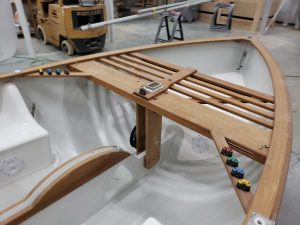
As soon as the wood is on, the boat is almost done. Alex adds the essential hardware – mast fittings, bow plate – and then flips the boat to add the keel strip, bailers and gasket.
And that, ladies and gentlemen, is your blank boat! If you love the thought of meticulously adding your own hardware, you can buy a blank boat from Beacon Composites for $19,000 (2021-22 pricing). Add a trailer with custom bunks to take it home for $2,960.
What’s it like moving from big boats to small ones?
Of the 13 boats Alex made at Winter Custom Yachts, the biggest boat he worked on from start to finish was 65 feet. “I worked on everything on that boat and managed the shop. There were nine of us on the project, but I had a good part. I did the glasswork, the furniture, the exterior, and the wood staircase, lids and doors. (Curious to see it? Go to www.wintercustomyachts.com/models/23 for photos.)
How does that compare to making a Thistle? “It’s far easier to make a Thistle!” Alex laughs, “They’re so much smaller than the sportfishing boats. But building Thistles is exciting because I like to sail.”
Time for hardware
For the standard option, Alex installs mostly Harken hardware with a couple Ronstan parts mixed in. While the layout is pretty standard, there are a few key upgrades. For example, Alex uses mini 360s for the boom vang and centerboard leads, but rather than being notched into the cap, they’re put through a hole. “If you decide to change your system, you could put a fairlead or a plug in the hole.”
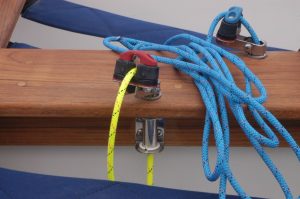
This standard-rigged hull with blades is yours for $25,500 (2021-22 pricing). How long will you wait from order to delivery? A mere 3 months. Remember how clean the infusion process is? In a shop, that translates to a faster turnaround.
If you have rigging ideas that differ from the norm, Alex is happy to consult with you on the specifics and cost of your custom rigging package.
A new way to make blades
To construct rudders, Alex started by taking the official plans and redrawing them on the computer. That gave him a cutting pattern for his CNC machine (a machine that uses automation to cut and shape a piece of material based on instructions from a computer program). The CNC machine creates a blank rudder by cutting the pattern into a piece of wood. From there, Alex hand-lays the fiberglass. “The tolerance is a fraction of a sixteenth of an inch when you do the glasswork and gel coat,” Alex explains. “I like using the computer. Each blank will start exactly the same. If there’s ever an issue, we can adjust the file. Most of my other custom work is like that – I do it on the computer first.”
Alex has a plan to make a rudder mold so he can make wood rudders for those who want them. He’s also developing a process to make centerboards; for now, he buys them from Great Midwest.
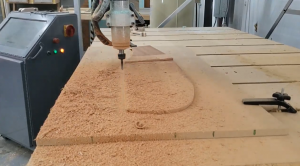
How did Alex get into the Thistle Class?
With his employer planning a move to the coast in 2018, Alex was preparing to launch his own boat-building business in Raleigh-Durham. He also had the itch to race sailboats again and was looking into the Carolina Sailing Club.
As luck would have it, John Norton walked into Winter Custom Yachts to talk about new builder options for the class. John sails Thistle 4000 at the Carolina Sailing Club. John and Alex met and had the first of many conversations about building Thistles. “I told him, ‘I want to do that! I can make those!’” Alex recounts. “The Thistle was a good opportunity for me to take on a line of boats, which is what I wanted to do. It was a really exciting opportunity.”
And as for racing at the Carolina Sailing Club, Alex hopped in John’s Thistle and crewed for him for two years. He joined Tim and Dawn Elfenbein for the 2021 Nationals.
“I enjoy building, and I enjoy boats, so it’s fun to put the two together.”
Maintenance and repairs
Along with building new boats, Alex also does maintenance and repairs at the Beacon Composites shop. He recently repaired a Highfield lever that had rotted out on one boat and replaced a few front grating pieces to give the owner a blank slate on another. He can also help with paint jobs, new rails, glasswork, new hardware…the list keeps going.
Have a question about repairing your current boat (or buying a new one)? Give him a call or stop in! “I like talking about it, so feel free to stop by and visit the shop.”
What does Alex think about the Thistle Class?
“The class is very competitive but very friendly! I was surprised by how many people were actively racing. I don’t have people I can race against in the Farrier 32 trimaran I built. And that’s what I wanted to do: get back into racing in a competitive fleet. It’s a really good time!”
Want to start a conversation with Alex? Visit www.beacon-composites.com.
